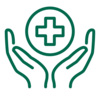Keratoconus is a progressive, non-inflammatory disease of the cornea, mainly affecting teenagers and young adults. It manifests itself as a progressive weakening of the corneal tissue, leading to thinning and conical deformation of the cornea.
In Turkey, several specialized ophthalmology centers offer state-of-the-art treatments, adapted to each stage of the disease. Thanks to the combined expertise of ophthalmic surgeons and access to the latest technologies, it is now possible to treat keratoconus in a targeted and safe way.








